by Eric Meier
When attempting to identify a wood sample, it’s important to keep in mind the limitations and obstacles that are present in our task. Before starting, please have a look at The Truth Behind Wood Identification to approach the task in a proper mindset; I consider the linked article to be required reading for all those visiting my site with the intent of identifying wood.
1. Confirm it is actually solid wood.
Before proceeding too much farther into the remaining steps, it’s first necessary to confirm that the material in question is actually a solid piece of wood, and not a man-made composite or piece of plastic made to imitate wood.
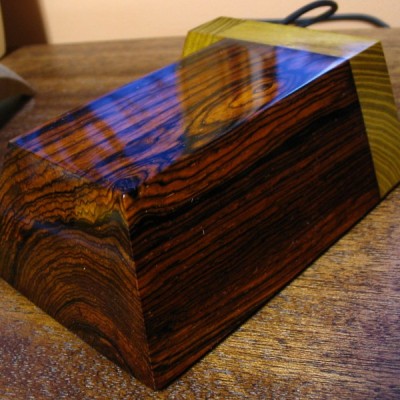
Can you see the end-grain?
Manufactured wood such as MDF, OSB, and particleboard all have a distinct look that is—in nearly all cases—easily distinguishable from the endgrain of real wood. Look for growth rings—formed by the yearly growth of a tree—which will be a dead-giveaway that the wood sample in question is a solid, genuine chunk of wood taken from a tree.
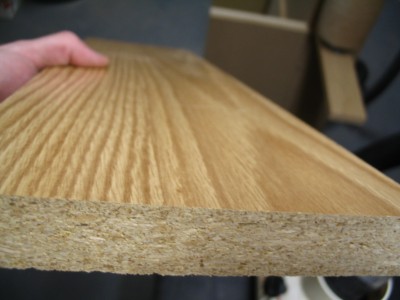
Is it veneered?
If you see a large panel that has a repeating grain pattern, it may be a veneer. In such cases, a very thin layer of real wood is peeled from a tree and attached to a substrate; sometimes the veneer can be one continuous repeating piece because it is rotary-sliced to shave off the veneer layer as the tree trunk is spun by machines. Assuming it is a real wood veneer with a distinct grain and texture—and not merely a piece of printed plastic—you may still be able to identify the outer veneer wood in question, but you should still realize that is it only a veneer and not a solid piece of wood.
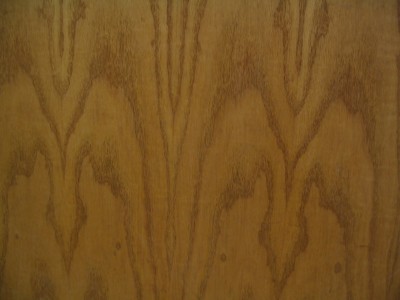
Is it painted or printed to look like wood?
Many times, especially on medium to large-sized flat panels for furniture, a piece of particleboard or MDF is either laminated with a piece of wood-colored plastic, or simply painted to look like wood grain. Many of today’s interior hardwood flooring planks are good examples of these pseudo-wood products: they are essentially a man-made material made of sawdust, glues, resins, and durable plastics.
2. Look at the color.
Some questions to immediately ask yourself:
Is the color of the wood natural, or is it stained?
If there is even a chance that the color isn’t natural, the odds are increased that the entire effort of identifying the wood will be in vain.
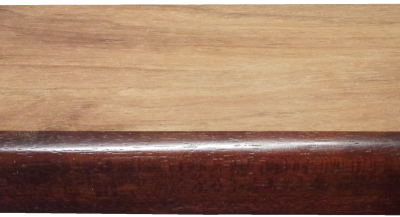
Is it weathered or have a patina?
Many woods, when left outside in the elements, tend to turn a bland gray color. Also, even interior wood also takes on a patina as it ages: some woods get darker, or redder, and some even get lighter or lose their color; but for the most part, wood tends to darken with age.
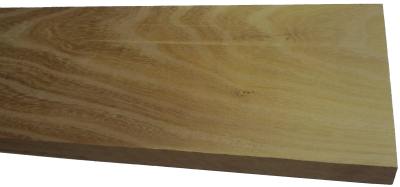
Is it possible to sand or plane the board to see the natural raw color of the wood?
The most predictable baseline to use when identifying wood is in a freshly sanded state. This eliminates the chances of a stain or natural aging skewing the color diagnosis of the wood.
3. Observe the wood grain.
If the wood is unfinished, then look at the texture of the grain. Ask yourself these questions:
Does the wood have an open, porous texture?
Most softwoods will be almost perfectly smooth with no grain indentations, while many common hardwoods have an open pore structure, such as oak or mahogany; though there are some hardwoods that are also smooth to the touch, such as maple.
Can you tell if the wood is quartersawn or plainsawn?
By observing the grain patterns, many times you can tell how the board was cut from the tree. Some wood species have dramatically different grain patterns from plainsawn to quartersawn surfaces. For instance, on their quartersawn surfaces, lacewood has large lace patterns, oak has flecks, and maple has the characteristic “butcher block” appearance.
Is there any figure or unusual characteristics, such as sapwood, curly or wild grain, burl/knots, etc.?
Some species of wood have figure that is much more common than in other species: for example, curly figure is fairly common in soft maple, and the curls are usually well-pronounced and close together. Yet when birch or cherry has a curly grain, it is more often much less pronounced, and the curls are spaced farther apart.
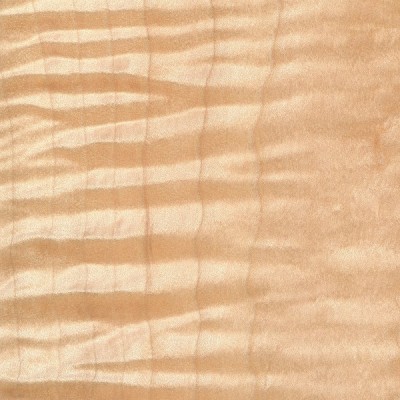
4. Consider the weight and hardness of the wood.
If it’s possible, pick the piece of wood up and get a sense of its weight, and compare it to other known wood species. Try gouging the edge with your fingernail to get a sense of its hardness. If you have a scale, you can take measurements of the length, width, and thickness of the wood, and combine them to find the density of the wood. This can be helpful to compare to other density readings found in the database. When examining the wood in question, compare it to other known wood species, and ask yourself these questions:
Is the wood dry?
Wood from freshly felled trees, or wood that has been stored in an extremely humid environment will have very high moisture contents. In some freshly sawn pieces, moisture could account for over half of the wood’s total weight! Likewise, wood that has been stored in extremely dry conditions of less than 25% relative humidity will most likely feel lighter than average.
How does the wood’s weight compare to other species?
Taking into account the size of the board, how does its weight compare to other benchmark woods? Is it heavier than oak? Is it lighter than pine? Look at the weight numbers for a few wood species that are close to yours, and get a ballpark estimate of its weight.
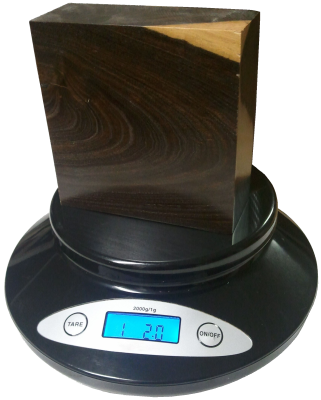
How hard is the wood?
Obviously softwoods will tend to be softer than hardwoods, but try to get a sense of how it compares to other known woods. Density and hardness are closely related, so if the wood is heavy, it will most likely be hard too. If the wood is a part of a finished item that you can’t adequately weigh, you might be able to test the hardness by gouging it in an inconspicuous area. Also, if it is used in a piece of furniture, such as a tabletop, a general idea of its hardness can be assessed by the number and depth of the gouges/dings in the piece given its age and use. A tabletop made of pine will have much deeper dents than a tabletop made of Oak. Additionally, you can always try the “fingernail test” as a rough hardness indicator: find a crisp edge of the wood, and with your fingernail try to push in as hard as you can and see if you’re able to make a dent in the wood.
5. Consider its history.
Many times we forget common sense and logic when attempting to identify wood. If you’ve got a piece of Amish furniture from Pennsylvania, chances are more likely that the wood will be made of something like black walnut or cherry, and not African wenge or jatoba. You might call it “wood profiling,” but sometimes it can pay to be a little prejudiced when it comes to wood identification. Some common-sense questions to ask yourself when trying to identify a piece of wood:
Where did it come from?
Knowing as much as you can about the source of the wood—even the smallest details—can be helpful. If the wood came from a wood pile or a lumber mill where all the pieces were from trees processed locally, then the potential species are immediately limited. If the wood came from a builder of antique furniture, or a boat-builder, or a trim carpenter: each of these occupations will tend to use certain species of woods much more often than others, making a logical guess much simpler.
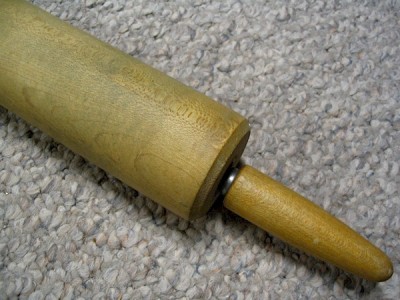
How old is it?
As with the wood’s source, its age will also help in identification purposes. Not only will it help to determine if the wood should have developed a natural patina, but it will also suggest certain species which were more prevalent at different times in history. For instance, many acoustic guitars made before the 1990s have featured Brazilian rosewood backs/sides, yet due to CITES restrictions placed upon that species, East Indian rosewood became a much more common species on newer guitars. (And this is a continuing shift as newer replacements are sought for rosewoods altogether.)
How large is the piece of wood?
Some species of trees are typically very small—some are even considered shrubs—while others get quite large. For instance, if you see a large panel or section of wood that’s entirely black, chances are it’s either painted, dyed, or stained: Gaboon ebony and related species are typically very small and very expensive.
What is the wood’s intended use?
Simply knowing what the wood was intended for—when considered in conjunction with where it came from and how old it is—can give you many clues to help identify it. In some applications, certain wood species are used much more frequently than others, so that you can make an educated guess as to the species of the wood based upon the application where it was used. For instance, in the United States: many older houses with solid hardwood floors have commonly used either red oak or hard maple; many antique furniture pieces have featured quartersawn white oak; many violins have spruce tops; many closet items used aromatic red cedar, and so forth. While it’s not a 100% guarantee, “profiling” the wood in question will help reduce the number of possible suspects, and aid in deducing the correct species.
6. Find the X-Factor.
Sometimes, after all the normal characteristics of a sample have been considered, the identity of the wood in question is still not apparent. In these instances—particularly in situations where a sample has been narrowed down to only a few possible remaining choices—it’s sometimes helpful to bring in specialized tests and other narrower means of identification.
The following techniques and recommendations don’t necessarily have a wide application in initially sorting out wood species and eliminating large swaths of wood species, but will most likely be of use only as a final step in special identification circumstances.
Odor
Believe it or not, freshly machined wood can have a very identifiable scent. When your eyes and hands can’t quite get a definitive answer, sometimes your nose can. Assuming there is no stain, finish, or preservative on or in the wood, quickly sand, saw, or otherwise machine a section of the wood in question, and take a whiff of the aroma.
Although new scents can be very difficult to express in words, many times the scent of an unknown wood may be similar to other known scents. For instance, rosewoods (Dalbergia spp.) are so named for their characteristic odor that is reminiscent of roses. Although difficult to directly communicate, with enough firsthand experience scents can become a memorable and powerful means of wood identification.
Fluorescence
While certain woods can appear basically identical to one another under normal lighting conditions, when exposed to certain wavelengths—such as those found in blacklights—the wood will absorb and emit light in a different (visible) wavelength. This phenomenon is known as fluorescence, and certain woods can be distinguished by the presence or absence of their fluorescent qualities. See the article Fluorescence: A Secret Weapon in Wood Identification for more information.
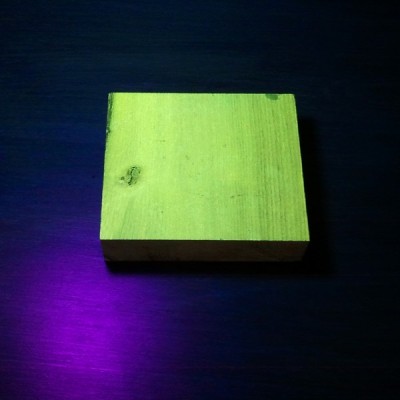
Chemical Testing
There are only a small number of chemical tests regularly used on wood, most of which are very specialized and were developed to help distinguish easily confused species with one another. They work by detecting differences in the composition of heartwood extractives. A chemical substance (called a reagent) is usually dissolved in water and applied to the wood surface: the surface is then observed for any type of chemical reaction (and accompanying color change) that may occur. Two of the most useful are the tests that are meant to separate Red and White Oak, and Red and Hard Maple.
Heartwood Extractives Leachability
Sometimes a wood species will have heartwood extractives that will be readily leachable in water and capable of conspicuously tinting a solution of water a specific color. For instance, the heartwood extractives contained in osage orange (Maclura pomifera) contain a yellowish-brown dye that is soluble in water. (This can sometimes be observed anecdotally when the wood is glued with a water-based adhesive: the glue’s squeeze-out is an unusually vibrant yellow.)
In a simple water extract color test, wood shavings are mixed with water in a vial, test tube, or other suitably small container, and the color of the water is observed after a few minutes. If the heartwood extractives are leachable by water, then a corresponding color change should quickly occur.
In addition to osage orange (Maclura pomifera), merbau (Intsia spp.), and rengas (Gluta spp. and Melanorrhoea spp.) are also noted for their readily leachable heartwood extractives. Because this property is quite uncommon, it can serve to quickly differentiate these woods from other lookalikes.
7. Look at the endgrain.
Perhaps no other technique for accurate identification of wood is as helpful and conclusive as the magnified examination of the endgrain. Frequently, it brings the identification process from a mostly intuitive, unscientific process into a predictable, repeatable, and reliable procedure.
Looking at the endgrain with a magnifier shouldn’t be a mystifying or esoteric art. In many cases, it’s nearly as simple as examining small newsprint under a magnifying glass. There are three components necessary to reap the full benefits contained in the endgrain:
I. A prepared surface.
When working with wood in most capacities, it becomes quickly apparent that endgrain surfaces are not nearly as cooperative or as easily worked as face grain surfaces. However, in this case, it is absolutely critical that a clear and refined endgrain surface is obtained.
For a quick glance of a softwood sample, a very sharp knife or razor blade can be used to take a fresh slice from the endgrain. However, in many denser species, especially in tropical hardwoods, one of the best ways to obtain a clear endgrain view is through diligent sanding. It’s usually best to begin with a relatively smooth saw cut (as from a fine-toothed miter saw blade) and proceed through the grits, starting at around 100, and working up to at least 220 or 320 grit, preferably higher for the cleanest view.
II. The right magnifier.
It need not be expensive, but whatever tool is used to view the endgrain should have adequate magnifying power. In most instances, 10x magnification is ideal, however, anything within the range of 8 to 15x magnification should be suitable for endgrain viewing. (Standard magnifying glasses are typically in the range of 2 to 4x magnification.)
These stronger magnifiers, sometimes called loupes, usually have a smaller viewing area than standard magnifying glasses. Fancier models—with built in lights, or larger viewing surfaces—are available at a premium; but the most basic models are usually only a few dollars.
III. A trained eye.
The third element that constitutes a proper endgrain examination is simply knowing what to look for. In analyzing the patterns, colors, shapes, and spacing of the various anatomical features, there is a veritable storehouse of information within the endgrain—all waiting to be unlocked. Yet, if these elements have not been pointed out and learned, the array of features will simply seem like an unintelligible jumble. The discipline of recognizing anatomical endgrain features is not easily summed up in a few sentences or even a few paragraphs, but it is nonetheless critical to the identification process. To this end, an in-depth look should be given to the various categories, divisions, and elements that constitute endgrain wood identification on the macroscopic level. (In this regard, macroscopic denotes what can be seen with a low-powered, 10x hand lens—without the aid of a microscope—rather than simply what can be seen with the naked eye.) Because the anatomy between softwoods and hardwoods is so divergent, each will be considered and examined separately:Still stumped?
If you have a mysterious piece of wood that you’d like identified, you’ve got a few options for next steps:USDA’s Forest Products Laboratory
You can mail your physical wood samples to the Center for Wood Anatomy Research.
Pros:
- Free
- Professional wood identification
Cons:
- Only available to US citizens
- Slow turnaround times (up to a month or more)
- Limited to three IDs per year
See their Wood ID Factsheet for more info.
Alden Identification Service
You can mail your physical wood samples (even small sections taken from antiques) to Alden Identification Service.
Pros:
- Professional wood identification
- Faster turnaround times (ranging from a few days to a week or two)
Cons:
- Paid service
See their ordering page for more info. (Note that Harry Alden has written several books while at USDA, including both Hardwoods and Softwoods of North America.)
Ask for help online
If the wood ID is merely a curiosity, or non-critical, you can post pictures of the wood in question.
Pros:
- Free
- No need to send physical samples
Cons:
- Greatly limited by the quality of the pictures provided
- Extra work usually required to get adequate clarity in photos
See article of Common US Hardwoods to help find the most commonly used woods.
Get the hard copy
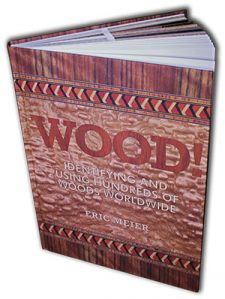 If you’re interested in getting all that makes The Wood Database unique distilled into a single, real-world resource, there’s the book that’s based on the website—the Amazon.com best-seller, WOOD! Identifying and Using Hundreds of Woods Worldwide. It contains many of the most popular articles found on this website, as well as hundreds of wood profiles—laid out with the same clarity and convenience of the website—packaged in a shop-friendly hardcover book.
If you’re interested in getting all that makes The Wood Database unique distilled into a single, real-world resource, there’s the book that’s based on the website—the Amazon.com best-seller, WOOD! Identifying and Using Hundreds of Woods Worldwide. It contains many of the most popular articles found on this website, as well as hundreds of wood profiles—laid out with the same clarity and convenience of the website—packaged in a shop-friendly hardcover book. 





Why I will no longer be replying to every wood ID request I’ve replied to literally thousands of wood ID requests on this site over the past 13+ years, but as the site’s popularity has grown, so has the time demands for ID on a daily basis. (Contrary to what some may seem to think, I am not some all-knowing wood wizard that can instantly ID your wood. It can actually take me a long time to sift through a lot of different resources.) Over the past few years, my backlog of pending wood species to be added to the… Read more »
Passed down from my grandparents I was told it was a rare type of wood perhaps rose wood?
I don’t think it’s rosewood, but it does look like some type of imported tropical hardwood. Some possibilities that come to mind are pheasantwood (or any Senna species), some species of partridgewood, or lastly some type of Albizia species, such as monkeypod.
Hey if anyone would be able to help me, I’ve been struggling to identify and pin down what kind of timber this is, I’m from the UK but I doubt the wood is, I found it being used as a pallet bearer at the workshop I am at, however I have no sense of smell so I cannot give any information on that aspect, I have attached pictures of it planed, as well as the darker unplaned edge as that is its colour after years in the sun, the sapwood is very white and I have also attached an endgrain… Read more »
That looks like padauk or some other Pterocarpus species to me.
Hi Eric this is a followup I sent you message frw days ago re dresser unknown wood that I am attempting to know more about. Here are few more pics. The end part of a drawer and back and front original pulls which I had saved..So much nicer than the cheap stuff I replaced them with. we do crazy things in our youth. Right??
Pics:
Not sure. Oak? Any thoughts would be appreciated.
Eric, a few years back you were able to help me identify some Philippine Mahagony. I have another request if you have the time. The main color is medium to dark brown and has reddish streaks. I have included pictures, top and end grain. I think it came from some hardwood flooring that a friend of mine gave me. I am leaning very heavily towards a walnut, but I am not certain.
Thank you.
Definitely not walnut. More than likely an imported tropical hardwood used for flooring. I’ve not quite finished the article on streaked woods yet, but there’s still a section on streaked hardwood flooring that might be of help: https://www.wood-database.com/striped-streaked-and-veined-woods/
After digging around your very extensive site, I think I have narrowed it down to Cumaru. The secondary name of BrazilianTeak does sound like what a flooring salesman might use to make it sound exotic. Grain patterns and end grain seem to match up fairly well. My pieces have more pronounced streaks of red. Thanks for pointing me in a good direction.
This is a musical instrument. The maker does not recall what wood it is – he says he would have to smell it to know for sure – but he thinks it it is either “Juniper” or “Western cedar.” I don’t think it is Western red cedar. I have another instrument from him made from Western (red) cedar, and the smell is not the same. This one is aromatic. I think it is too light colored to be eastern redcedar ((Juniperus virginiana). Might you know what it could be? Thank you in advance.
I think if you trust your nose enough to distinguish them, you could probably rule out western red cedar. It doesn’t look like eastern red cedar. The slight sanding unevenness between the growth rings indicates a very lightweight wood, so going by the maker’s own words, I’d lean towards juniper. Wester juniper is a species that can fit into this category, but that’s just a guess.
Hi Eric. This is a followup to i.d. request. I did watch your video as suggested. TY@ also I will be photographing the end grain on the dresser in question( corner of drawer) btw the joints are dovetailed.ok thank you-ellen
Hello. About 50 years ago I purchased this 6 drawer dresser from a small thrift here in NY. It has remained with me thru a lot( believe me) Upon purchasing for some reson I replaced matching wooden drawer pull. Luckily I kept originals.
Can you tell if this is teak or walnut?
I appreciate your help.
Thank you-Ellen
Want to restain this bench not sure what kind of wood it is. It was passed on from my parents, probably 20 yrs old. Already started sanding some of it. Not super light but not super heavy
Was just interested looking through these comments and pictures. Looks like Sheesham if that helps!
Hello, I have started to restore a Hathaway dresser that was my great Grandmothers. It is mixed with solid and veneer. I’d like to know what type of wood so I can finish properly. Thank you
Hey Eric,
I trust your Friday is going well! Hey, I would LOVE to get your opinion on this one. I’ve taken numerous pictures as well as some video!
Location is Middle Tennessee.
https://olen.synology.me:5021/mo/sharing/9ify1uWhL
If you rather I put pictures here, just let me know. I don’t think I can put the videos here though?
BTW, I’ve changed servers and those pictures and videos will load MUCH faster now. Just mentioning that because you may have previously been annoyed with how long it was taking to load them.
To be honest, I’m not that good with TREE identification. I’d really need to see a close up picture of endgrain to do proper WOOD ID.
Try to figure out what type of hardwood this is so, I can a decide what type of wood finish to use. Will be a shelve for outdoor use.
Hello,
Hope you experts can help me identify what type of wood I have in my home.
I want to buy the swiffer wet jet to use on the floors but want to make sure it will not damage the floors.
The wood smells nice -has a sweet note to it.
Thank you in advance for your help in identifying my flooring.
That’s a prefinished “hand-scraped” flooring product. Absolutely safe for a swiffer wet mop. These micro-beveled flooring planks are typically factory finished with an aluminum-oxide protective coating so the mild cleaning agents in a swiffer pose no risks.
Trying to ID the wood on this dresser. 1970s Ethan Allen. I’m thinking it’s pine, but not sure. Pretty light weight. I’ve stripped it once in this pic, so it still has some color from the stain.
With the knots and how the planks absorbed stain unevenly between soft and hard grain it sure looks like pine to me.
Hey Eric,
Great article!
Is there a resource available that has photos of wood grains for classification purposes?
I have photos of what appear to be an untreated tabletop, but having a hard time identifying what family of wood (or even likely specific wood this is).
I want to say a softwood, but not certain!
Someday I hope to make an online ID key that will systematically walk through each step and narrow down the possibilities after each question. Until then, I’ll just say that the wood in your picture looks a lot like maple to me!
Thank you Eric! That’s a great idea! Perhaps, one day, you could even leverage machine vision to help site visitors identify their wood using AI vision classification + general feedback provided by the user! Thanks for flagging as potentially Maple! This looks like a butcher-block style table (60 x 24), and at its pricepoint ($75), I thought it would be a more accessible/economical-type wood. I’ll have to check it out in person over the coming day or two to be certain — any tips/pointers I can use to confirm the Maple classification? I was concerned it would be a softwood… Read more »
You could try digging your fingernail into an inconspicuous corner of the wood. Hard maple shouldn’t leave much of a dent at all.
Sure looks like maple from here. Economical price point likely because of the short lengths used and wide variety in character. Maple butcher block of continuous pieces end to end would be more costly.
Hello, this is a photo of freshly sanded solid wood flooring. Can someone please let me know the species.
Tough to tell from that single picture, but looks like Ash or Walnut.
I too am saying that’s Walnut, based upon the difference in the heartwood/sapwood and the fact that it has a grey cast to it.
I brought 21 sticks of this wood back from England in 1984, and only recently turned this handle from one of them. I think I was told then that it was Cuban mahogany, but am not sure. In any case I am terribly allergic to its dust.
Definitely not mahogany. Those very large rays are very distinctive. Probably from the Proteaceae family, so lacewood, leopardwood, or a silky oak species of some sort.
Could Someone please identify my new tabletop
Can you identify this for me please – I’m in the uk and was gifted this sideboard – it’s old and needs some tlc – thank you very much (it is extremely heavy!)
Possibly walnut
Thank you so much Eric, much appreciated
We found this tree dead for quite a while and was going to cut it up for firewood but it’s simply to beautiful to burn. I turned in on the lathe and this was end result hoping you can identify this we are stuck between black walnut or elm
I was asked to make a bandsaw box by a customer who provided me with this 30+ yo block of wood. He believes it’s local to South Carolina and he thinks it’s spalted cherry. I’ve got a strong feeling it’s a nut wood such as pecan or chestnut. Very dry- 6-7%. Any help would be greatly appreciated. Thanks!
Well, you’re right in that it’s not cherry. It appears to be a ring porous hardwood, and to me it very much looks like a species of ash. The arrangement of the latewood pores in wavy bands is similar to elm, but I don’t think it’s consistent enough to be elm. Ash seems to fit closely with that characteristic. Catalpa and sassafras are two similar woods with a low density too that could be considered.
Thanks Eric! Here’s a pic of the bark if that helps narrow it down.
Looking to find out the wood type from this antique cabinetry of my mothers
hello, can someone please identify this wood for me
Did you ever get a answer to your question,? Im pretty sure I have a night stand made of the same wood but I haven’t been able to find out what it is, if you happen to know could you please let me know, it would be greatly appreciated
I believe it’s called knotty pine I took a picture of it and used Google lens and that’s what came up, I’m still trying to find out what kind of table it is exactly I started restoring it and it would be nice to know what it is I have the legs have been pieced together very strange and someone has added nails to it , I’ll upload a photo of it and hopefully someone can give me an idea what it is. Thanks in advance
Trying to determine if this is rubberwood? Regardless of what it is, can it be stained?
Hi: I got this old cutlery tray and i was wondering what kind of wood it is made of. Measures 13 inches long X 8 inches long X 4 inches tall (5 1/2 on the handle)
Weighs close to 2.8 lbs
-Sorry forgot to attach pictures
Could be clear Douglas Fir.
Watt kind of tree is Thisted. Zebra wood?
It looks like a Millettia species, possibly wenge.
More like Wenge than Zebrawood to these eyes.
This true 2″ by 4″ piece of lumber is one of many which I removed while demo’ing an old room in my house, which was built in 1905. I don’t know much about construction lumber, however I believe this lumber was produced maybe 60ish years ago? It’s dense, feels solid and without using a scale, it feels heavier compared to a modern 2×4. Any Ideas? Thank you in advance!
An old growth softwood. I can’t see any resin canals, and you would probably smell if it were pine anyway. I’m going to guess that it’s western larch, or possibly Douglas fir.
Okay. Thank you. Was this species common in house construction? When I think of Douglas for or softwood as you said, I think of yellow or light color pieces and not as solid as the stuff I have. Is the example I asked you about just aged that much to where it sounds solid and feels heavy? And each of the 2x4s I have are almost perfectly straight . I considered borrowing someone’s planer to clean them and use them in some kind of project or maybe sell them.
When it comes to softwood construction lumber like this, there really is a huge difference between the old growth wild-grown stuff that would’ve been encountered 100 years ago, and the plantation grown stuff seen today. There’s a reason why a lot of the old stuff is actually reclaimed and salvaged–and sold at a premium. It tends to be a stronger and harder than modern stuff.
What type of wood is this? Light Oak, Dark Oak, Maple, something else? I am just trying to pick a wood filler/sealant as close to the original colour as possible. Thanks
That’s a softwood of some sort, i.e., pine, fir, etc.
CVG Doug Fir will make for a decent match to the more linear grained pieces but will be more pink/red/orange. Hard pine could work as well, but will have more of a yellow tone.
Hello, Eric, I rescued an antique handmade dresser in Connecticut. It is colonial in style, I am estimating circa 1880’s-1900’s. While I know the drawer fronts are birdseye maple, it is the drawer bottoms and sides that I need help identifying the wood species. The drawer bottoms are each made of 1 solid piece of wood approximately 17″x22″ Due to its large size I’m guessing it to be old growth wood. It is very light in weight like cedar- but even after sanding there is no scent. The sawdust is orangey in color, also possibly indicating cedar or pine. The… Read more »
Hello,
This is current state of the dining table after some sanding. Can anyone see what kind of wood it is? Thanks!
Looks like a softwood, possibly pine.
Found in a house that was built in 40 in convent La
Softwood species of some type.
Hey Eric,
Here’s hoping you catch it at a glance cause itd driving be crazy. If not, no worries. Thanks for your hard work and have a great day!
From a futon frame made in Malaysia. The knots have a very fresh pungent scent almost like a mix of pine and cedar when sanded.
Its probably something incredibly common but I can’t find any photos of anything that has that bold red and white two-tone online.
I appreciate your time brother, thank you and take care!
Yes, that’s pine. You can see the big resin canals pretty clearly on the endgrain. Not sure on exact species, possibly something plantation grown.
Oh man, thank you sir! I figured it had to be, I had just grown up around pine and oak mostly and had never seen pine with tones of red that prominent.
Really appreciate it, been driving me crazy!
No particular smell, dense and heavy. Can someone assist with what species this can be ??
Hi! Can you tell me what kind of wood this old Easter Island dude is? Thanks SO MUCH!
We are trying to id the wood species of this coffee table. No stain, just clear oil finish. Thanks.
Any ideas what this wood species is? It weighs a little *more* than 0.368209 oz/cubic inch, or 637 kg/cubic meter or 0.637 grams/cubic centimeters. (I say *more* because there’s a tongue on one end that’s not offset by a corresponding grove.) It’s 3.5 inch by .75 inch flooring. Many thanks!
It looks like old growth red oak. Oak has one interesting property in that the slower it is grown, and the closer the growth rings are, the lighter it actually becomes.
Any ideas what this wood species is?
Wood (lol) anyone be able to identify this wood for me?
Hi Eric. I wonder if you can help me in the identification of this wood sample. Presumably from south america (not sure); Density of 740 Kg/m3; smells quite a lot like Platymiscium spp.); but note having any of the reddish hues of Platymiscium. Thank you in advance for your time.
My dad bought me a slice to work on a commission for a friend, he *thinks* he remembers them saying it was maple, but now after asking in several places I’m not sure if it is black walnut, butternut, or something else. I plan to do some pyrography on it so the wood type has the potential to really make a difference 1
Second photo for wood ID
Help with identifying this carved wood box. Fairly large and intricate designs inside and out. I’ve included a photo of where a corner broke off. Any help is appreciated. It’s very dry but want to identify it so I don’t mess it up. Thanks.
Claro Walnut
Thank you! Happy Thanksgiving!
I see that there are some apps around which identify ‘things’ like birds (Merlin) and plants (Seek) by taking photographs or recording sounds. Just wondering if there is something, or if it being worked on, which using a database of images of woods including wood veneers, can similarly identify a wood from a photograph. I would not want to underestimate the work involved since each ‘wood’ can have a number of ‘looks’ and there is the issue of if it has been treated with a varnish of some sort. Such treatments would have to be reasonably ‘clear’ and I know… Read more »
There are potentially two varieties of apps that you are describing, one that looks at the face grain, and one that looks at the endgrain. The ones that look at the facegrain are very inaccurate in all but the most limited of circumstances. The only situations where I could see a facegrain ID app potentially working would be if you could also input a context ahead of time, something like “this wood is from vintage flooring planks from New England” or some other way to drastically reduce potential candidates so that there’s realistically only a few potential options. The other… Read more »
Thank you for your helpful comments. I am interested in identifying pieces of wood veneer which are fairly thin. So facegrain is what is seen and as such it seems this may mean identification may not be possible. However, you do say that additional information could help. So for example I guess it could help to choose which of a number the user thinks it could be.
I will have
a look at Xylorix.
Can you identify what type of wood this is? It was bought from Montgomery Wards as a diningroom table and china closet new around 1977. 100% wood, not veneer or particleboard. Between fairly heavy and extremely heavy
Can someone please help me identify this wood. I’m not asking anyone to do any research but would be interested in your first initial thoughts to what it may be. My first guess would be Ike or Paduk (although Paduk may be a stretch, though). Thanks for any input.
Definitely not padauk. Ipe is a possibility, along with a large amount of tropical hardwoods.
Thanks Eric
Just in case you might know this one off the top of your head. Here’s the pics
Possibly sycamore
I am trying to get these colours together, I have started with rosewood but don’t know what else to use
Kind regards
Jilly
Hi again. Thanks for all you do here. Hopefully you’ve the time to ID this piece for me. Sold as ironwood. No distinct odour. Reddish brown, seemingly VERY porous. I worked the density to be about 865kg/m3 and feels quite hard on my nail. Many thanks
Just thought I’d reply with my initial guess. Burma Padauk is what I’m thinking, bang on with density but the colouration and pores make me unsure. Cheers.
Here are the pictures (2nd attempt)
~1750 long case clock by William Yeadon. He normally used oak. Is this cherry? Very small infrequent knots. Polishes/stains to a much darker colour. Unfinished in dovetail shot inside hood
Any help gratefully received
Pete
This house was built in the 1930s or 1940s and has 0 signs of termites, so I think it is cedar. The smell is faint, and the wood is very, very dry and super tough. Very hard to break tongue and groove. My friend thinks it is Knotty Pine, but I feel it is too tough, and has no signs of bugs.
Please help if you can.
Thank you,
Daniel
Can someone help me identify the tree I have cut. It seems to have a very distinct color and growth ring pattern. It’s hard to see the lighter color is olive to yellow and in some places seem to alternate between the dark brown and yellow rings. Smooth bark. I live in Tennessee